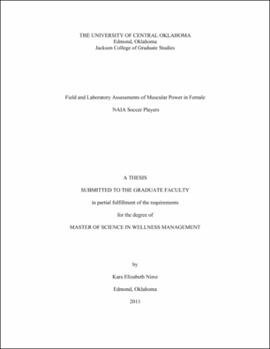| dc.contributor.advisor | Farnell, Gregory | |
| dc.contributor.author | Nimz, Kara E. | |
| dc.date.accessioned | 2020-05-26T20:37:38Z | |
| dc.date.available | 2020-05-26T20:37:38Z | |
| dc.date.issued | 2011 | |
| dc.identifier.other | (AlmaMMSId)9978545885202196 | |
| dc.identifier.uri | https://hdl.handle.net/11244/324676 | |
| dc.description.abstract | The primary purpose of the investigation was to determine the most closely related assessment between the agility t-test, countermovement vertical jump, fly-in 40-yard dash, lower limb length, and percent body fat when correlated to kicking power as measured by the Tendo FitroDyne Powerlizer. The study also aimed to form a prediction model based on all of the independent variables that could be used to predict soccer-specific kicking power. The study included 21 female soccer players (19 + 0.92 years) from Saint Gregory's University (n=11) and Oklahoma City University (n=10). The best score from the Tendo, agility t-test, countermovement vertical jump, and fly-in 40-yard dash was recorded for each participant. The percentage of body fat was determined using skinfold calipers and limb length was measured on the dominant kicking leg. A Pearson's correlation coefficient was used to identify relationships between kicking power and each of the independent variables. A backward multiple regression was administered in order to determine the independent variables that were able to best predict kicking power. The results from the Pearson's indicated that a significant relationship exists between kicking power and percent body fat (r = 0.630, p = .001) and limb length (r = 0.418, p = .047) while no significant relationships exist between kicking power and each of the field assessments of lower limb power. The backward multiple regression results indicate that limb length and percent body fat are the best predictors of kicking power. The primary investigator concluded that although the correlations between kicking power and limb length and %BF were significant, the field assessments of lower limb power were not correlated to kicking power indicating that the Tendo may not have effectively measured the instep soccer kick. | |
| dc.rights | All rights reserved by the author, who has granted UCO Chambers Library the non-exclusive right to share this material in its online repositories. Contact UCO Chambers Library's Digital Initiatives Working Group at diwg@uco.edu for the permission policy on the use, reproduction or distribution of this material. | |
| dc.subject.lcsh | Soccer | |
| dc.subject.lcsh | Women soccer players | |
| dc.title | Field and laboratory assessments of muscular power in female NAIA soccer players. | |
| dc.type | Academic theses | |
| dc.contributor.committeeMember | Pink, Bill | |
| dc.contributor.committeeMember | Powers, Melissa | |
| dc.thesis.degree | M.S., Wellness Management | |
| dc.identifier.oclc | (OCoLC)ocn840690036 | |
| uco.group | UCO - Graduate Works and Theses::UCO - Theses | |
| thesis.degree.grantor | Jackson College of Graduate Studies | |
